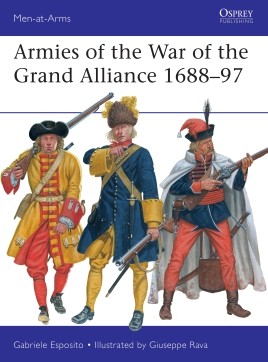On the blog today, author Gabriele Esposito gives us an overview of how the great coalition against Louis XIV was created. Recent series title Armies of the War of the Grand Alliance 1688–97 explores the armies that fought in the war to stop the Sun King's expansionism.
The War of the Grand Alliance was one of the greatest European conflicts to take place during the second half of the 17th century. Also known as the Nine Years’ War and the War of the League of Augsburg (after the military coalition of several European states), it lasted from 1688 to 1697. This ‘Grand Alliance’ was created with one key objective: to oppose the expansionism of King Louis XIV of France.
Since 1648, under the leadership of the ‘Sun King’, France had gradually become the leading military power in Europe, fighting several wars against other European countries to expand its national territories. Louis XIV, the perfect embodiment of an ‘absolute monarch’, wanted to conquer Alsace and Lorraine on his eastern borders, part of the Holy Roman Empire under the Habsburgs, plus the Spanish Netherlands (present-day Belgium) and the Dutch territories on his northern borders. After the signing of the Peace of Westphalia (1648), France greatly improved its armed forces and obtained new territories along the Rhine. During the following decades, Louis XIV implemented his expansionist policy and attacked most of the countries that surrounded him. In 1667–1668, he invaded the Spanish Netherlands during the so-called ‘War of Devolution’ which ended with significant territorial acquisitions on France’s northern borders. During 1672–1678, he attempted to conquer the Netherlands in a conflict known as the ‘Dutch War’. This war gave France new territories but contributed to the ruin of its economy as well as causing significant human loss. In 1681, the French Army took the important city of Strasbourg after a brief campaign against the Holy Roman Empire (1683–1684) and was then engaged in a new conflict known as the ‘War of the Reunions’, fighting against the Holy Roman Empire and Spain for possession of the Spanish Netherlands. This new war ended with a temporary truce and Luxembourg was given to France. At the same time, the French were also fighting the Duchy of Savoy in northern Italy to capture the strategic fortress of Pinerolo that dominated the city of Turin.
All of these wars indicated to other European states that France was gearing up for a new conflict on a larger scale. France had expanded its navy and was acquiring more colonial possessions overseas. In fact, The War of the Grand Alliance would also be fought in North America, where it is still known as ‘King William’s War.’
In 1685 Louis revised the political stance of France by signing the Edict of Fontainbleau which decreed Protestantism illegal. The measure was presented as a way to stabilize internal politics and to combat a perceived Protestant (‘Huguenot’) threat but in reality served to consolidate anti-French feeling and provoke a mass exodus of Protestants to countries such as the Netherlands and England.
By 1688 Louis, reigning from his newly-built palace of Versailles, had done his best to bring old historic enemies together against France. Two powerful monarchs were ready to oppose him: the Stadtholder of the Netherlands, William of Orange, and the Holy Roman Emperor, Leopold I. William was considered to be the champion of Protestantism across Europe; Leopold I had been at war with France for most of his life since the age-old rivalry had begun between Habsburgs and Bourbons. In addition, the defeat of the Ottoman Army which had besieged Vienna in 1683 had freed up vast numbers of Imperial troops involved in campaigns against the Turks and large numbers of the 200,000 Huguenots exiled from France in the Netherlands and England hoped that these countries would help remove Louis XIV from his throne. French Protestants in the Duchy of Savoy in search of safety continued to be persecuted by French military forces operating from the fortress of Pinerolo so much so that Savoy no longer wanted to accept such intrusive foreign interference and was prepared to join any anti-French alliance.
In late September 1688, after issuing an ultimatum to which no response was given by the other European powers, Louis XIV ordered his troops to cross the Rhine and besiege the city of Philippsburg. On 20 December 1689, all countries fighting against France formed a strong military alliance known as the League of Augsburg (after the German city). This comprised the Holy Roman Empire, England, the Netherlands; and later (in 1690) Spain and Savoy.
MAA 541: Armies of the War of the Grand Alliance 1688–97 is available to order here


Comments
You must be logged in to comment on this post. Click here to log in.
Submit your comment